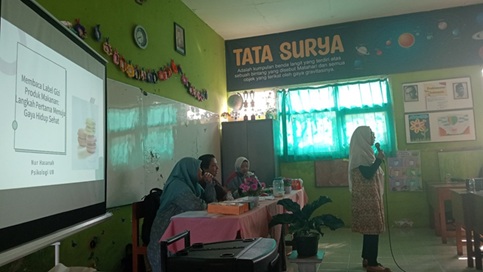Memahami Nutrition Facts: Satu Langkah Kecil untuk Hidup Lebih Sehat Understanding of Nutrition Facts: One Small Step for Healthier Life
Main Article Content
Abstract
Parents have a central role in determining what their family members will consume, therefore, one of the skills that parents must have is the ability to understand nutrition facts on food packaging. This Community Service aims to provide education to parents of students to improve health literacy in understanding nutrition facts listed on a food or beverage product. The method used is giving a lecture on the material on how to read nutrition facts or nutritional value information, where 56 parents of elementary school students (M = 34.179, SD = 1.086) were involved as audiences. Measurements were taken twice before and after the provision of material to see the effectiveness of the method. The results of the analysis showed that there was a significant difference between the scores before and after the provision of material, which means that education on nutrition facts can improve the health literacy of parents of students regarding nutritional label information on packaged foods.
Downloads
Article Details

This work is licensed under a Creative Commons Attribution-ShareAlike 4.0 International License.
Authors who publish with this journal agree to the following terms:
- Any article on the copyright is retained by the author(s).
- Author grant the journal, right of first publication with the work simultaneously licensed under a Creative Commons Attribution License that allows others to share work with acknowledgment of the work authors and initial publications in this journal.
- Authors are able to enter into a separate, additional contractual arrangements for non-exclusive distribution of published articles of work (eg, post-institutional repository) or publish it in a book, with acknowledgment of its initial publication in this journal.
- Authors are permitted and encouraged to post their work online (e.g., in institutional repositories or on their websites) prior to and during the submission process, as can lead to productive exchanges, as well as earlier and greater citation of published work.
- The article and any associated published material is distributed under the Creative Commons Attribution-ShareAlike 4.0 International License
References
Anggraini, S., Handayani, D., & Kusumastuty, I. (2018). Tingkat pengetahuan cara membaca label informasi gizi mahasiswa status gizi normal lebih baik dibandingkan mahasiswa obesitas. Indonesian Journal of Human Nutrition, 5(2), 74–84. https://doi.org/10.21776/ub.ijhn.2018.005.02.2
Carruba, G., Calagna, M. L., Campisi, I., Cutrera, S., Napoli, L., Pitti, G., Palmisano, V., Savio, G., Usset, A., Leonardi, V., Di Pasquale, A., Requirez, S., & Blasi, L. (2022). Unmet nutritional and psychological needs of cancer patients: An Integrated Multi-Professional Model Approach. Diseases, 10(3), 47. https://doi.org/10.3390/diseases10030047
Chauvin, I. (2020). The value of integrating nutrition in mental health counseling and treatment. Integrative Journal of Conference Proceedings, 2. https://doi.org/10.31031/icp.2020.02.000531
Hasanah, N., Diniari, I., & Fitriani, A. (2017). Influence of age and education on purchase intention of halal labelled food among indonesian muslim mothers. Global Journal of Business and Social Science Review (GJBSSR), 5(3), 165–169. http://dx.doi.org/10.35609/gjbssr.2017.5.3(18)
Laporan Riskesdas 2018 Nasional.pdf. (n.d.). https://repository.badankebijakan.kemkes.go.id/id/eprint/3514/1/Laporan%20Riskesdas%202018%20Nasional.pdf
Magoda, T., C., & Rizal, A. (2024). Buku Ajar Penatalaksanaan Gizi Masyarakat. NEM. https://books.google.co.id/books?id=MTDyEAAAQBAJ&printsec=frontcover&hl=id&source=gbs_ge_summary_r&cad=0#v=onepage&q&f=false
Owen, L., & Corfe, B. M. (2017). The role of diet and nutrition on mental health and wellbeing. Nutrition Society. https://doi.org/10.1017/s0029665117001057
Palupi, I. R., Naomi, N. D., & Susilo, J. (2017). Penggunaan label gizi dan konsumsi makanan kemasan pada anggota persatuan diabetisi Indonesia. Kes Mas: Jurnal Kesehatan Masyarakat, 11(1), 1–8. https://doi.org/10.12928/kesmas.v11i1.2065
Puspasari, N., & Andriyani, M. (2017). Hubungan pengetahuan ibu tentang gizi dan asupan makan balita dengan status gizi balita (BB/U) usia 12-24 bulan. Amerta Nutrition, 1(4), 369–378. https://doi.org/10.20473/amnt.v1i4.2017.369-378
Worlh Health Organization. (2017). WHO. 2017. Track 2: Health Literacy & Health Behaviour. https://www.who.int/%20healthpromotion/conference/79chp/track2/en/
Yuhansyah, Y. Y. (2019). Gambaran tingkat pengetahuan ibu tentang gizi pada anak balita di UPT Puskesmas Remaja Kota Samarinda. Borneo Nursing Journal (BNJ), 1(1), 76–83. https://journals.indexcopernicus.com/publication/3949061
Zarotti, N., Coates, E., McGeachan, A., Williams, I., Beever, D., Hackney, G., Norman, P., Stavroulakis, T., White, D., White, S., Halliday, V., McDermott, C., & on behalf of the HighCALS Study Group. (2019). Health care professionals views on psychological factors affecting nutritional behaviour in people with motor neuron disease: A thematic analysis. British Journal of Health Psychology, 24(4), 953–969. https://doi.org/10.1111/bjhp.12388
